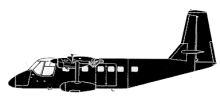Incident Overview

Description
During the certification process, the GAF N24 Nomad encountered problems with longitudinal stability at the 20ø flap setting. In the opinion of the Chief Test Pilot, the stick force gradient was unacceptable at the 20ø flap setting. While the longitudinal stability problem may not have affected Australian certification of the N24, it was considered important to solve the problem for a developed version of the aircraft. Accordingly, the Government Aircraft Factories (GAF) made and flight tested a series of modifications to the tailplane. Before the accident flight the full-span trim tabs were fitted with 50 mm T strips. The purpose of the flight on which the accident occurred was to examine the effect of these tailplane modifications on the longitudinal stability of the aircraft in the 20 degree flap configuration required for the N24A model. It was intended that, after take-off, the aircraft would proceed to a designated flight test area where, at a safe altitude, the tests would be carried out. The aircraft was not to be flown at a speed in excess of 120 knots equivalent airspeed (EAS). At 10:51 hours the pilot of the aircraft, using his personal radio callsign GAF ONE, contacted Avalon Tower by radio and advised that he had received the current aerodrome terminal information and was taxiing. The aircraft then taxied to the east-west grass strip. At 10:58 hours Avalon Tower advised the aircraft of the local weather and that there were aircraft reports of extensive cloud and build-ups to the south-west moving in a north-easterly direction. The pilot acknowledged this information. At 11:00 hours the aircraft notified that it was ready for take-off and the controller advised that there would be a short delay, which was due to other traffic landing on the runway. At 11:00:23 hours the Nomad was cleared for take-off and an unrestricted climb. The aircraft took off into the west from the grass strip and, immediately it became airborne, the pilot applied a series of ‘push-pull’ control inputs to the tailplane after which the aircraft commenced its initial climb. The aircraft climbed straight ahead in a normal manner and reached a height of about 950 feet when over or just past the runway. At this point three witnesses on the ground observed the trailing edge of the aircraft’s tailplane fluttering and he saw a dark object fall from the aircraft to the ground. At about this time the aerodrome controller, located in the control tower some 1250 metres south-east of the aircraft, saw it adopt a steep nose-down attitude and asked whether operations were normal. The pilot replied ‘negative’, and the aerodrome controller then initiated emergency procedures and the crash alarm was sounded. The aircraft then turned left onto a southerly heading while still descending, and may have maintained this heading briefly before continuing to turn left onto an easterly heading. Just prior to contact with the ground, the left wing and the nose dropped, and after impact the aircraft rotated through 120 degrees in the horizontal plane and skidded rearwards for a distance of some 70 metre before coming to rest. For the flight on which the accident occurred the aircraft carried the trade-plate registration VH-SUZ. CAUSE: “The cause of the accident was that the simplified design criterion which was used to justify freedom from flutter during the flight testing of various tailplane modifications was not valid for a design which included tab trailing edge T strips.”
Source of Information
https://news.google.com/newspapers?id=g59WAAAAIBAJ&sjid=H-cDAAAAIBAJ&pg=2851%2C5825982https://news.google.com/newspapers?id=g59WAAAAIBAJ&sjid=H-cDAAAAIBAJ&pg=2851%2C5825982Primary Cause
The simplified design criterion used for freedom from flutter during tailplane modification testing was deemed invalid for the specific aircraft configuration, particularly considering the presence of tailplane trailing edge tabs.The simplified design criterion used for freedom from flutter during tailplane modification testing was deemed invalid for the specific aircraft configuration, particularly considering the presence of tailplane trailing edge tabs.Share on:




